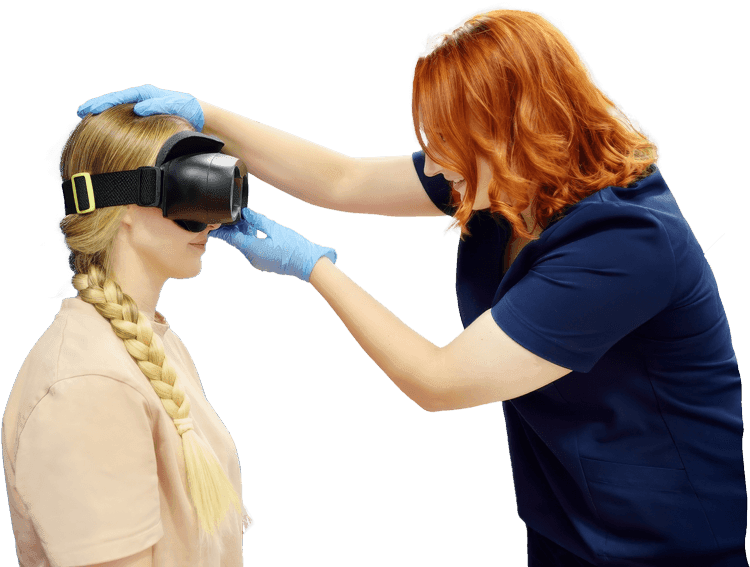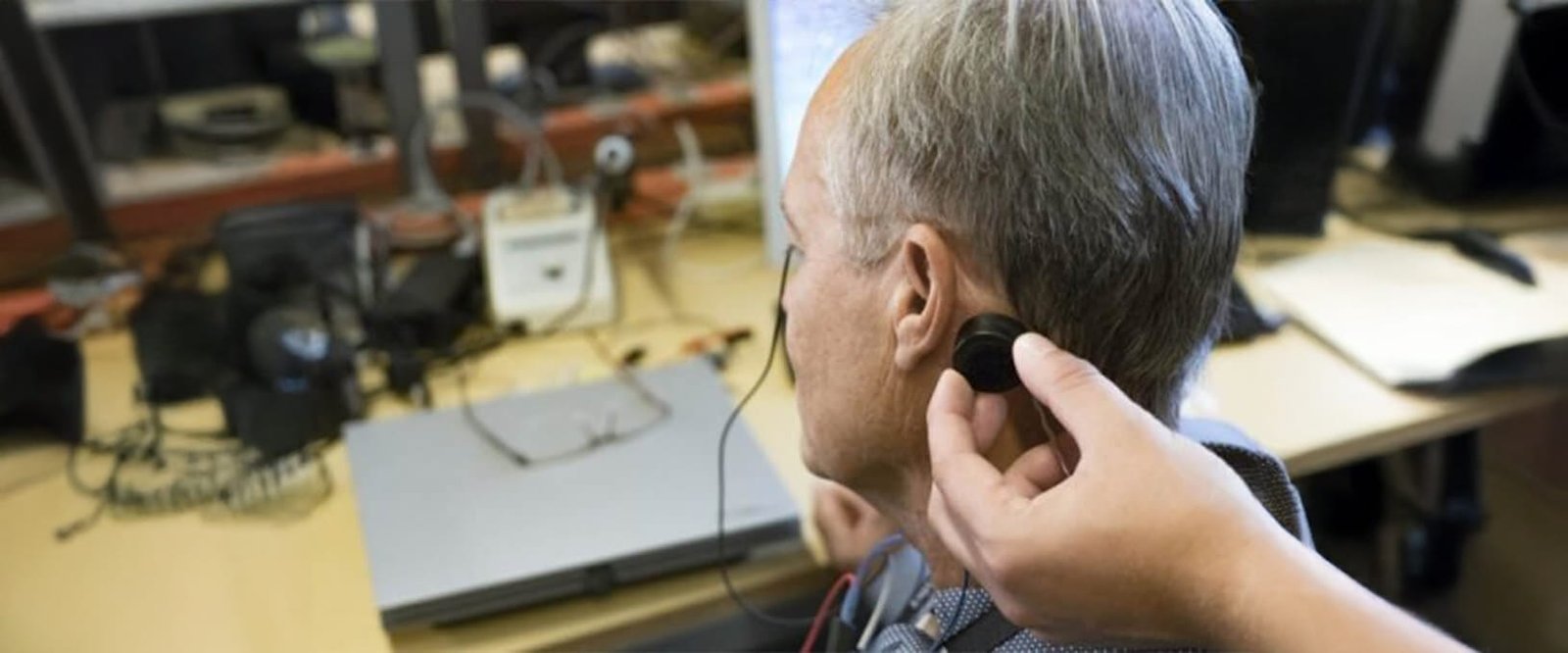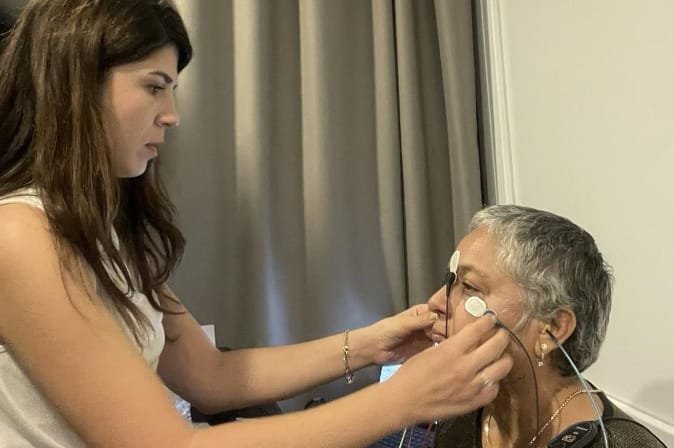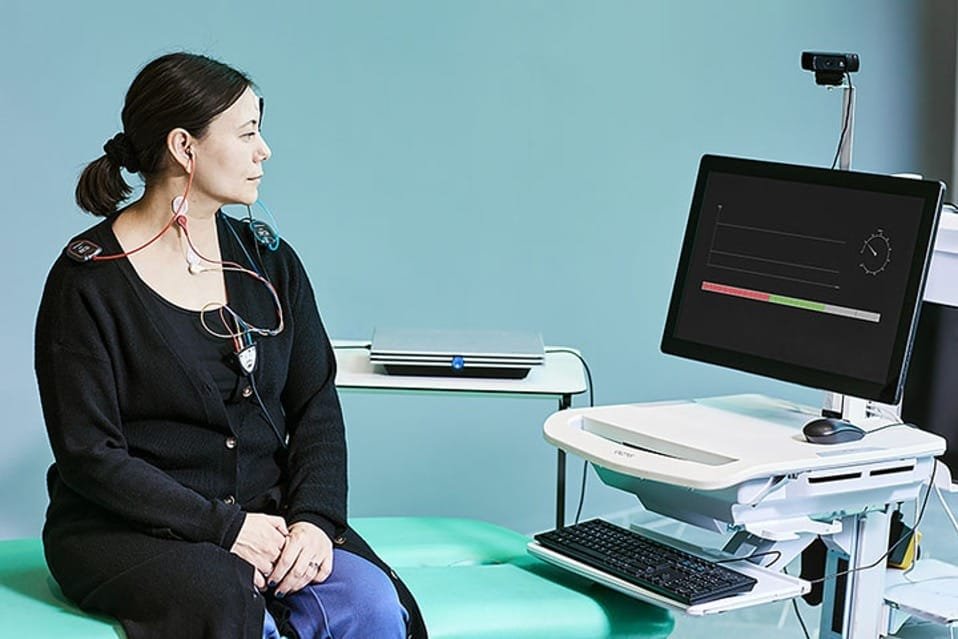VEMP Test
The VEMP test, or “Vestibular Evoked Myogenic Potential” test, is a diagnostic tool that provides information about the vestibular system in the inner ear.

Discover the True Cause of Your Vertigo!
Understanding the source of dizziness and problems with your balance is the first step towards the right treatment. Book your appointment for an individualized assessment with our team of experts and regain your health.
As part of vestibular evaluation, this test is particularly used to assess the functions of the saccule (a component of the balance organ in the inner ear) and the inferior vestibular nerve.

How the VEMP Test Works
The VEMP test is performed using stimuli such as sound or vibration. During the test, high-frequency sound waves are delivered to the ears, which stimulate the saccule and vestibular nerve. The reflex responses triggered in the muscles (typically the neck or eye muscles) are then measured. The VEMP test is divided into two main types:
- cVEMP (Cervical VEMP):
Measures responses from neck muscles and evaluates the saccule and inferior vestibular nerve functions. - oVEMP (Ocular VEMP):
Measures responses from the muscles around the eyes and evaluates the utricle and superior vestibular nerve functions.
Importance of the VEMP Test in Vestibular Evaluation
The VEMP test is used to investigate the causes of vestibular symptoms such as dizziness, imbalance, and vertigo. It provides:
- Evaluation of the otolith organs (saccule and utricle) in the inner ear.
- Detection of functional impairments in specific branches of the vestibular nerves (inferior and superior).
- Diagnostic support for vestibular disorders such as Meniere’s disease, vestibular neuritis, otosclerosis, and superior canal dehiscence syndrome.
Unlike traditional hearing tests, the VEMP test gives detailed information about balance functions and is highly valuable for identifying damage or loss of function in specific areas of the vestibular system.
How the VEMP Test is Conducted?

1. Preparation Stage:
- The patient is made comfortable in a quiet environment where external noise is minimized.
- The areas where electrodes will be placed (face, neck, or around the eyes) are cleaned. Surface electrodes (small adhesive pads) are then attached.
- For cVEMP (neck muscles), electrodes are placed over the neck muscles. For oVEMP (eye muscles), electrodes are placed around the eyes.
2. Starting the Test:
- The patient wears headphones, and sound stimuli at specific frequencies and intensities are delivered through them.
- These stimuli trigger reflex responses in the saccule or utricle of the inner ear. The response travels through the vestibular nerves to the muscles, generating short-lived electrical activity.
- This electrical activity is recorded from the neck muscles (cVEMP) or the eye muscles (oVEMP).
3. Measurement and Analysis:
- During the test, electrodes measure the reflex responses in the muscles caused by sound stimuli.
- These responses are recorded as waveforms on a computer for analysis.
- The characteristics of the waveforms, such as amplitude, symmetry, and shape, are evaluated. Absent or abnormal responses may indicate a dysfunction in the vestibular system.

When is the VEMP Test Used?
The VEMP test is particularly useful in evaluating the following conditions:
- Meniere’s Disease:
In this condition, which involves disrupted fluid balance in the inner ear, cVEMP can evaluate saccule function. Saccule damage, common in Meniere’s disease, often alters VEMP responses. - Vestibular Neuritis:
This inflammation of the vestibular nerve can be assessed using oVEMP, which evaluates utricle and superior vestibular nerve function. - Superior Canal Dehiscence (SCD) Syndrome:
A condition caused by bone thinning in the superior semicircular canal. This syndrome often presents with hypersensitivity, and VEMP helps in its diagnosis. - Otosclerosis:
An abnormal bone growth in the inner ear, where the VEMP test can indicate how balance functions are affected.
Interpreting VEMP Test Results
- Normal Response:
A recorded waveform indicates a healthy vestibular system. Symmetrical responses in both ears are particularly important. - Weak or Absent Response:
If no electrical response is detected or if the response is significantly weak, it may suggest a loss of function in the relevant vestibular structure (e.g., saccule or utricle). - Asymmetrical Responses:
Significant differences between the responses of the right and left ears can indicate an issue with one side of the vestibular system.
After the VEMP Test
The VEMP test is typically quick and painless. While the patient may feel mild discomfort during the procedure, there are no lasting side effects after the test. Based on the results, an ENT specialist can provide a diagnosis and recommend appropriate treatment options.
I am 34 years old. I have been having problems with infection and hearing loss due to ruptured eardrum since the age of 10. I wanted to have surgery and I went to many doctors. None of them were positive about me having surgery. They said my ears would not be healed with surgery. They recommended hearing aids. Upon the advice of a friend, I met Mustafa. He performed a very successful surgery. My hearing was cured. I got rid of the infection. Thank you very much for everything.
I am very happy with my teacher. He is a doctor who is very experienced in his job. His team is also knowledgeable. I think you should choose Mustafa without hesitation. I don't know any other doctor. I recommend him to everyone. He is a doctor who works hard, listens to his patient, and understands what he wants.
My quality of life has officially increased, I can breathe much easier. I would like to thank my teacher and his team very much.
We met with Mr. Mustafa Deniz for my son's adenoid surgery. He made me feel very comfortable with his interest and explanations. Our doctor is really a very sincere person. Our surgery was very successful, thank God. I had surgery a few months ago. I had a cyst in my throat. He explained my surgery process and my situation to me with the same interest and concern. My surgery went very well, thank God. Mr. Mustafa Deniz is successful in his job, valuable and a good person. The people who work with them are very valuable and good people. I'm glad I met you 🙂
I had nose surgery. I am in my 4th month. I am very satisfied. Thank you to my teacher Deniz.
I found Dr. Mustafa as a result of my research and went to him with the complaint of lack of ventilation of the Eustachian tube and decreased hearing. I had had surgery on the ear many times before, so he looked at my nose and said that there was a curvature in the nasal bone and a serious devaluation. If we correct it, it would benefit the ear and it would help me breathe in the future. So we did the surgery. We decided to be together, now I'm getting some fresh air and my hearing has improved a little, he said I'll be better, may God bless him, his communication and friendliness was very good, I'm glad to have you. my teacher
Hello, I have had a Vertigo disorder that has not gone away for three years. I reached out to our esteemed teacher Mustafa Deniz upon his advice. Thanks to the medications he gave as a result of the maneuvers and examinations he made, I have not had any dizziness for 4 months. Thank you very much to our esteemed teacher and his teammates, I am glad to have you, best regards.
I went to the doctor with a complaint of symptom perforation. He said that he could easily close it after the examination. I had my surgery in April 2024. He also performed deviation and nose tip aesthetics. My priority was, of course, to repair the perforation. Thank God, the hole closed and I also had a beautiful nose. My recovery process is still ongoing, it was a long and difficult surgery, but I can breathe healthy. During this process, Ms. Ayşegül was always just a phone call away. I also thank him very much for his interest.
If you are reading this article right now, you are in search of information like us. For this reason, I will tell our story in a little detail so that maybe it will be of some help to you. My daughter is 3 years old, we take her to our pediatrician regularly and when necessary. Our adventure started with nasal congestion. I am talking about a congestion that does not go away even though we constantly open it. Afterwards, mouth opening and snoring. When we asked our pediatrician about this situation, he referred us to Mustafa Hodja. After the examination of the adenoid size, He said it was 90%. We heard the sentence we didn't want: 'There should be surgery.' You'll be right, as a mother, I didn't want to have a young child undergo surgery right away. I even shared the situation with my pediatrician. He said, 'If Mustafa Hodja says, get it done, he won't say it easily. Make an appointment right away. We created the surgery and two days later, my baby had surgery. The only difficult thing about this surgery was waiting outside while your child was inside. Apart from that, everything was very planned and professional. The evening we came home, my baby was not snoring. He slept and we were incredibly surprised by this situation. We did not experience any negative situation. I would like to express our endless gratitude to Mustafa Hodja once again. Ms. Ayşegül, who did the programming, guided us very well. I am glad our paths crossed. Sleep without snoring, may the children be happy❤️
Septal perforation Due to a nose surgery I had years ago, there were 2 huge holes and no cartilage was left in the nose. I could breathe very hard because all the cartilage in my nose had worn away. I did a lot of research and consulted many doctors. They said it was a very risky surgery, they said we couldn't do it. I tried a lot, I researched a lot, and lastly, Mustafa Deniz. I met my doctor Yilmaz, I found his clinic and went to be examined, he said that it was a risky surgery but he could do it. Actually, I had some fears, but after the examination, he made me overcome that fear. I had septal performance and plastic surgery. It took about 11 hours. It took 4 months. I got excellent results. The holes in my nose were closed, with the cartilage taken from the rib. My nose has become more beautiful again than before. I can breathe very easily. I would like to thank my teacher Mustafa very much. He is a very good teacher, I think he is the best in this field.
I applied to my doctor with the complaint of septal perforation. I had surgery. It has been 5 months since my surgery and I am seriously relieved. Thank you very much to my doctor and his team...
I repaired the hole in my nose painlessly and regained my health very quickly, thanks to our teacher. Thank you again.
We left Van and came to Antalya for my teacher Mustafa Deniz Yılmaz. He was very friendly and helped us a lot, he took one-on-one attention. My surgery was very difficult. I was diagnosed with septal perforation (hole in the nose). Many doctors we went to said that it was difficult and there were only a few people who did it, and Mustafa He directed me to my marine instructor. He took very good care of me and performed my surgery successfully. Thank you very much to him and his team. I'm glad to have you.
Dear Sir, First of all, I would like to thank you. At first we used it for 5-6 hours, then I used it for 1.2 hours, no problem, thank you.
I took my mother, who was treated for vertigo in various hospitals for almost two months but could not get any results. As a result of detailed examination and tests performed by audiologists, Mustafa determined that she had balance nerve inflammation. The treatment, which was expected to last 4 weeks, was completed in almost 2 weeks, accompanied by expert audiologists. His condition is very good, he returned to his normal life, thank you to everyone who contributed 🙏🏻
First of all, I would like to express my endless gratitude to my marine instructor and all his staff. After a long wandering, I found my marine instructor upon his recommendation. He solved my dizziness problem that disrupted the entire routine of my life. May God bless you. REGARDS.
My daughter had adenoid surgery at the age of 6. Thank God, she is very well now. We chose my doctor because we trusted his knowledge and experience and we were not wrong. I recommend him as a doctor.
God bless my doctor. He performed a septum perforation (intranasal hole closure) surgery in January 2023. Thanks to him, I can now breathe easily. No matter how many doctors I went to, he said that you should get used to living with a hole in the nose. He is one of the rare doctors who attempted and succeeded in this surgery.9 He performed the hour-long surgery extremely successfully. I cannot thank and pray for him enough.
I am a patient who underwent radical mastoidectomy surgery. For those who don't know, it is a serious discomfort for the ear. You need to go to a competent doctor. I'm glad I found my teacher. Our teacher's knowledge, approach to treatment and kindness towards the patient are tremendous. While most doctors were afraid to clean my ear, he gave me the good news that I could swim in the sea after years. As a patient, I felt safe from the first moment. You can entrust yourself with peace of mind. Sir, I'm glad to have you...
As a physician, I was examined by my teacher. I was back and forth between neurology and ENT for months. My teacher sincerely answered the questions I had in my mind, both through clinical examination and advanced tests. You understand from the moment you enter his clinic that he is well-equipped and knowledgeable. I recommend it to everyone. Thanks
We crossed paths with our teacher because of the mucocele that appeared in my brother's mouth. We are in Istanbul, my brother works in Antalya. When one is abroad and experiences such problems, one feels such a deep need for a doctor one can trust that there is no way to describe this situation. First of all, we had a meeting with Ms. Ayşegül. He was so sincere and understanding that we felt cool. Our teacher Mustafa performed my brother's operation successfully. I would like to thank my teacher Mustafa and Ms. Ayşegül for all their support throughout the process. The existence of such doctors does not leave us helpless when it comes to diseases. May God bless you 🙏
Dear Professor Mustafa Bey, For many years, I had to have my ears cleaned every 5-6 weeks. I consulted many doctors in Europe, but no one could offer me an effective solution.However, you explained what my illness was and showed me the solutions. I sincerely thank you for the support you have provided me in this matter.
I was examined at Doctor Mustafa Deniz Yılmaz's clinic on August 26, 2024, with complaints such as tinnitus and inability to maintain balance. There was no clear diagnosis for the situation I was experiencing. With the doctor's brain diagnosis and the treatment we started, my tinnitus has decreased to 20% as of today. I am very happy that I am moving towards a solution on the fourth day of the two-month treatment. I owe a debt of gratitude…I am grateful for providing me with the comfort of sleeping soundly.
I went to Deniz Bey for vertigo. Thanks to Ms. Deliverye's tests, I was diagnosed correctly and I no longer have dizziness. Thank God, I can continue my life from where I left off, with the medicine given by Mr. Deniz and the exercise treatment by Ms. Deliverye. I am grateful to both of them.
I have been suffering from tinnitus for 35 years until I met my teacher Mustafa Denizi. I got examined on March 27th and he gave me medicines. Thanks to the medicines, I was so relieved in a short period of 3 months that I had no more dizziness and I had no tinnitus. I would like to thank Haham and his staff.
Hello, last year, in August 2023, my voice suddenly became hoarse and it did not go away, so I visited 3 hospitals, showed it to the ENT and looked for a solution to my problem, but they could not find anything, then upon the advice of a doctor, Prof. Dr. I came to Mustafa Deniz Yılmaz, I'm glad I came. He saw that I had a cyst on my vocal cord and operated on me. Since the cyst was attached to my vocal cord, he could not remove the entire cyst. He sent it to the doctor and asked for a report. In that report, it was seen that there was a cancerous cell on the remaining cyst. So, thank you for the remaining part. He sent me to treatment. Today, in March 2024, I came for a check-up and he gave me the good news that I was completely healed. If I can speak without any problems today, I owe it to him, thank you very much.
My complaint, which started with earache, continued with severe dizziness and nausea and vomiting. This process took 40 days, I went to more than 10 doctors during this time and could not get a correct diagnosis. Various maneuvers and wrong treatments were applied, thinking it was either an infection or a crystal shift, and my recovery time was extended, but I didn't feel well or stand up even for a day. Mr. M.Deniz diagnosed Balance Nerve Inflammation (vestibular neuritis) with examination techniques that no one else had done. I returned to my old life through the rehabilitation process. I would like to thank each and every one of you, the Doctor, the Audiologist, the Secretary and the dear people who put up with me during my 7 months of pregnancy, who worked hard for my recovery, and who stood by me until the end with their knowledge, equipment and sincerity, even though I never believed that I could recover in the sessions. 😇
Hello, my son had cochlear implant surgery at the age of 6. Our surgery, which had many risks, was very successful. Mustafa teacher and his assistants were very attentive before and after the surgery. They did their best for my son and continue to do so. I thank them very much. I'm glad to have you, Mustafa D. Teacher and MDY Clinic. team 🌺🤗❤️
Hello, I would like to thank our teacher MUSTAFA DENİZ, who performed tube follow-up adenoid surgery on my daughter Sine's ear when she was 4 years old, and now, at the age of 13, he also repaired the eardrum and brought my daughter back to health.
Hello, he saw the problem in my nose and throat, which had not been noticed for 2 months, and I returned to normal on the 3rd day... I would like to thank my teacher Mustafa.
Our mother had eardrum surgery 4 times before, and the disease recurred after a while in all of them. Then they recommended Mr. Mustafa, and we had the surgery done by him in one go. His attention was very good from the first day you went there, he was also very attentive after the surgery and now my mother's complaints have stopped. We thank him very much, we are glad we chose you. We wish you success…
My mother had a cough that did not go away for more than 20 years. It came in the form of cough attacks, lasted about 30-40 minutes, and affected her entire daily life. His voice was hoarse from coughing and he was feeling nauseous. It is not possible for me to express its severity in writing. Cough is a simple thing for a person who cannot see. For years, there was no doctor in Antalya or Ankara that we did not visit, they could not even diagnose us, let alone provide treatment. Still, many trial and error treatments were applied, but none of them even reduced his cough. As a result of my research, I found Mustafa Deniz Bey. As soon as he examined him, he made a diagnosis and started treatment. His treatment has been continuing regularly for 4 months and at this point, the cough has decreased by 80-90%. When he coughs, it is not in the form of attacks like before, but in the form of short-term cough, and his treatment is not over yet. After my mother has suffered for so many years, this seems enough for her. I cannot thank Doctor and his team enough. Fatma Hanım and Ayşegül Hanım are also very attentive, the whole team is the same, I'm sorry I can't write them one by one because I don't know their names. 😊 Thank you very much to everyone, I hope people like my mother who have been looking for a cure for their problems for years will see this comment and find healing for them too.
My son was diagnosed with otosclerosis in 2018 and he started using hearing aids in both ears after that date. I decided to have surgery on my son and as a result of my research, God brought my teacher Mustafa Deniz YILMAZ to us, we made our decision and got in touch. From the moment you contacted me to the surgery, dressing, stitch removal and this. We were very pleased with the interest and care shown to us by both my teacher and his staff and teammates in all kinds of communication during the period. May God bless them all, let's go to the surgery, your son had surgery, it was understood that the first diagnosis made during the surgery was tympobaplasty, but my teacher Mustafa performed a miracle. He re-established a hearing system in my son's ear, without using any foreign objects (prosthesis, etc.) with 100% success as a result of the hearing test. I will have his left ear operated on this year too. God bless my teacher Mustafa and his team. They laughed with us, got emotional and cried with us. What more can one expect from a doctor? Thank goodness for you, sir.
I would like to thank our teacher Mr. Mustafa and his colleagues for their interest and concern. They did a great job. I became a brand new me.
I was a dizziness patient who was diagnosed with Vertigo for a long time but couldn't find any cure. I reached him by following the doctor's Instagram. As a result of the tests and examination he performed, he said that I had a vertebral migraine. My medications were very good. I have not had any dizziness for 3 months. I am grateful to him. He saved me from a very troubled period. I recommend this center to all Vertigo patients who have not found a solution, thank you.
Thank you very much to our teacher, there is no doctor we haven't visited or medicine we haven't used. Thanks to you, we returned to our comfortable life. We can't thank you enough. We are grateful to you. Regards
I was previously diagnosed with Vertigo and maneuvers were performed. When my dizziness started again, I went to Dr. Mustafa Deniz and after the tests performed, he diagnosed me with Meniere's disease. I have been calling regularly about my medication dosage settings since May 2023. They answer with interest. I am very pleased. I will be able to stop taking my medications after a month. Then I'll call again anyway.😍
You are very successful as a doctor. We wish them continued success. You and your team are the only ones with vertigo.
I went to Prof Mustafa Deniz Yılmaz with a complaint of hearing loss upon his recommendation. Before being examined by Mr. Mustafa, I was examined by 2 professors and had 2 hearing tests done, one at the medical faculty and one in private. When my teacher Mustafa asked for a hearing test again, I thought to myself why it was necessary. However, when I saw the differences and details in the hearing test clearly, I saw how right he was. After examination and hearing test, he diagnosed otosclerosis. He stated that it would be appropriate to perform a tomography to strengthen the diagnosis and better analyze the situation. As a result of the tomography, he recommended surgery or headphones for treatment. My choice was for surgery. I would like to thank both Dr. Mustafa and the study team for informing me about the risks before the surgery and for their follow-up during the post-operative recovery process.
I would like to thank my doctor Deniz, who put an end to my 10-year hearing loss with a successful surgery about 3 months ago. He performed the same surgery on my wife a year ago and the surgery was very successful. Thank God, we both regained our health. I was diagnosed with otosclerosis 10 years ago in medical school. Hearing that the surgery would be risky. They told me that it would be more convenient for me to use the hearing aid. I have used a hearing aid for 5 years. I could not see any benefit anymore. During this process, my wife also had the same condition by chance. She went to medical school and said that too. They said that there was no place that could perform this surgery in Antalya. They suggested that we go to Ankara or Istanbul. As a result of long efforts and research, we found our teacher Deniz in Antalya. He and the team he worked with welcomed us very well. None of our questions were left unanswered. They contacted us immediately. Very We are satisfied..thank you to our teacher and his team. We are glad to have you.....
I am 16 years old. I had surgery for cholestealtoma by doctor Mustafa Deniz Yılmaz. My surgery was very successful. It has been 2 months since the surgery and my condition is very good.
I applied to Prof. Dr. Mustafa Deniz Yılmaz due to deviation and congestion in my nose. That's why I had surgery. The surgery went very well. I was informed by the doctor and his team at every stage. Afterwards, I returned to my normal life in a short time. I can breathe easy now. Prof. Dr. I would like to thank Mustafa Deniz Yılmaz and his team.
I was very pleased with my doctor and all the other staff. My surgery process went very well before and after 🙏🏻 my new nose and I are very happy 🥰🥰
Mr. Mustafa is a competent and expert Doctor, and a teacher who has proven himself especially in Vertigo.
I have been suffering from vertigo for a long time. I went to this department in medical school. I took the tests and did not see any benefit. I saw Instagram and looked at it. I thought I'd experience it. Mr. Deniz was very interested. He made his maneuvers. He asked questions about the possible causes. I took the test at the examination site. As a result of the tests, he told me what was the cause and what I should do. My medications worked well. After 3 months, we adjusted the dosage of the medications over the phone. After 1 month, we talked about my condition and the dosage of medications. He was very attentive with his staff. I suggest you try it. ☺️
My name is Ömer Faruk Taşcı. I am writing from Konya. I am receiving Menier treatment. I got sick about 7 months ago, and for the first 3 months I visited doctors in Konya in vain. I got worse day by day. The doctor sent me the antidepressant. Thanks to a friend of ours, we crossed paths with my teacher Mustafa Deniz Yılmaz. With my teacher's experience, knowledge and care for the patient, I was diagnosed and we knew what it was. This was even half of the treatment. Combined with advanced tests and technical knowledge, my treatment is going very well. The deadlines given by my doctor during the treatment were on time. The end of the 1st month was different. The end of the 2nd month was another. As they say, I started to get a response to the treatment after the 3rd month. I can say that the tinnitus is 90% gone. My balance is better and my dizziness is decreasing. My sleep has improved. I hope I will be better. The entire team is an expert in its work. I would also like to thank Ms. Delivery. Because of their interest and concern for us. After all, it is a place where you can go and get treatment with confidence. Of course, we have to continue the treatment with patience and trust our teacher.
Hello, I am suffering from vertigo syndrome for the past 5 years. I have visited many doctors and they all said it was permanent, but I found the solution in Mustafa Deniz Yılmaz and my attacks, dizziness and tinnitus disappeared. May God bless Mr. Mustafa and his team for their interest and concern, you can go there without hesitation.
Since I was 5 years old, I had hearing loss and infection in my ears caused by a ruptured eardrum. It affected my social life very badly. I could not communicate with people and this caused me to become depressed. I went to many places to have surgery, but no one had self-confidence. Did I really give up hope on everyone? I met Prof. Dr. Mustafa Deniz Yılmaz, he performed a very successful surgery, my hearing improved, the infection stopped completely, thank you very much for everything, may God bless you.
Fill out the form and
we will call you
Discover the True Cause of Your Vertigo!
Understanding the source of dizziness and problems with your balance is the first step towards the right treatment. Book your appointment for an individualized assessment with our team of experts and regain your health.

















































